Simulating Agronomic Adaptation Strategies to Mitigate the Impacts of Climate Change on Wheat Yield in South-Eastern Australia
Abstract
1. Introduction
2. Materials and Methods
2.1. Study Sites Characteristics
2.2. Climate Projections Data
2.3. Climate Change Impacts and Adaptation Strategies
2.4. Simulations
3. Results
3.1. Projected Climate Relative to Baseline
3.2. Impact of Projected Climate on Crop Phenology
3.3. Impact of Projected Climate Change on Crop Yield
4. Discussion
4.1. Climate Change Projections and Impacts
4.2. Adaptation Strategies
5. Conclusions
Funding
Institutional Review Board Statement
Informed Consent Statement
Data Availability Statement
Acknowledgments
Conflicts of Interest
References
- Workman, D. Wheat Exports by Country. Available online: http://www.worldstopexports.com/wheat-exports-country/ (accessed on 2 April 2020).
- Zeleke, K.T.; Nendel, C. Analysis of options for increasing wheat (Triticum aestivum L.) yield in south-eastern Australia: The role of irrigation, cultivar choice and time of sowing. Agric. Water Manag. 2016, 166, 139–148. [Google Scholar] [CrossRef]
- Scanlon, T.T.; Doncon, G. Rain, rain, gone away: Decreased growing-season rainfall for the dryland cropping region of the south-west of Western Australia. Crop. Past Sci. 2020, 71, 128–133. [Google Scholar] [CrossRef]
- Ainsworth, E.A.; Long, S.P. What have we learned from 15 years of free-air CO2 enrichment (FACE)? A meta-analytic review of the responses of photosynthesis, canopy properties and plant production to rising CO2. New Phytologist. 2005, 165, 351–372. [Google Scholar] [CrossRef]
- Tubiello, F.N.; Rosenzweig, C.; Goldberg, R.A.; Jagtap, S.; Jones, J.W. Effects of climate change on US crop production: Simulation results using two different GCM scenarios. Part I: Wheat, potato, maize, and citrus. Clim. Res. 2002, 20, 259–270. [Google Scholar] [CrossRef]
- Easterling, W.; Aggarwal, P.; Batima, P.; Brander, K.; Erda, L.; Howden, M.; Kirilenko, A.; Morton, J.; Soussana, J.F.; Schmidhuber, S.; et al. Food, fibre and forest products. In Climate Change 2007: Impacts, Adaptation and Vulnerability. Contribution of Working Group II to the Fourth Assessment Report of the Intergovernmental Panel on Climate Change; Parry, M.L., Canziani, O.F., Palutikof, J.P., van der Linden, P.J., Hanson, C.E., Eds.; Cambridge University Press: Cambridge, UK, 2007; pp. 273–313. [Google Scholar]
- Luo, Q.Y.; Bellotti, W.; Williams, M.; Bryan, B. Potential impact of climate change on wheat yield in South Australia. Agric. For. Meteorol. 2005, 132, 273–285. [Google Scholar] [CrossRef]
- Anwar, M.R.; Liu, D.; Farquharson, R.; Macadam, I.; Abadi, A.; Finlayson, J.; Wang, B.; Ramilan, T. Climate change impacts on phenology and yields of five broadacre crops at four climatologically distinct locations in Australia. Agric. Syst. 2015, 132, 133–144. [Google Scholar] [CrossRef]
- Ludwig, F.; Asseng, S. Climate change impacts on wheat production in a Mediterranean environment in Western Australia. Agric. Syst. 2006, 90, 159–179. [Google Scholar] [CrossRef]
- Wang, M.; Li, Y.; Ye, W.; Bornman, J.F.; Yan, X. Effects of climate change on maize production, and potential adaptation measures: A case study in Jilin Province. China Clim Res. 2011, 46, 223–242. [Google Scholar] [CrossRef]
- Wang, Y.P.; Connor, D.J. Simulation of optimal development for spring wheat at two locations in southern Australia under present and changed climate conditions. Agric. For. Meteorol. 1996, 79, 9–28. [Google Scholar] [CrossRef]
- Zunfu, L.; Feifei, L.; Guoquan, L. Adjusting sowing date and cultivar shift improve maize adaption to climate change in China. Mitig. Adapt. Strateg. Glob. Chang. 2019, 25, 87–106. [Google Scholar] [CrossRef]
- van Ittersum, M.K.; Howden, S.M.; Asseng, S. Sensitivity of productivity and deep drainage of wheat cropping systems in a Mediterranean environment to changes in CO2 temperature and precipitation. Agric. Ecosyst. Environ. 2003, 97, 255–273. [Google Scholar] [CrossRef]
- Diaz-Nieto, J.; Wiby, R.L. A comparison of statistical downscaling and climate change factor methods: Impacts on low lows in the river Thames, United Kingdom. Clim. Chang. 2005, 69, 245–268. [Google Scholar] [CrossRef]
- Moss, R.H.; Edmonds, J.A.; Hibbard, K.A.; Manning, M.R.; Rose, S.K.; Carter, T.R.; Emori, S.; Kainuma, M.; Kram, T. The next generation of scenarios for climate change research and assessment. Nature 2010, 463, 747–756. [Google Scholar] [CrossRef]
- Holzworth, D.P.; Huth, N.I.; Devoil, P.G.; Zurcher, E.J.; Herrmann, N.I.; Mclean, G.; Chenu, K.; Van Oosterom, E.J.; Snow, V.; Murphy, C. APSIM—Evolution towards a new generation of agricultural systems simulation. Environ. Model. Softw. 2014, 62, 327–350. [Google Scholar] [CrossRef]
- World Bank. Turn Down the Heat: Climate Extremes, Regional Impacts, and the Case for Resilience; 1818 H Street NW.; World Bank: Washington, DC, USA, 2013; Available online: www.worldbank.org (accessed on 6 May 2020).
- Randall, D.A.; Wood, R.A.; Bony, S.; Colman, R.; Fichefet, T.; Fyfe, J.; Kattsov, V.; Pitman, A.; Shukla, J.; Srinivasan, J.; et al. Climate models and their evaluation. In Climate Change; Solomon, S., Qin, D., Manning, M., Chen, Z., Marquis, M., Averyt, K.B., Eds.; The Physical Science Basis. Contribution of Working Group I to the Fourth Assessment Report of the Intergovernmental Panel on Climate Change; Cambridge University Press: Cambridge, UK, 2007; pp. 589–662. [Google Scholar]
- Zhang, X.; Cai, X. Climate change impacts on global agricultural water deficit. Geophys. Res. Lett. 2013, 40, 1111–1117. [Google Scholar] [CrossRef]
- Laurent, R.; Cai, X. A maximum entropy method for combining AOGCMs for regional intra-year climate change assessment. Clim. Chang. 2007, 82, 411–435. [Google Scholar] [CrossRef]
- Sacks, W.J.; Kucharik, C.J. Trends in crop management and phenology in the U.S. corn belt, and impacts on yields, evapotranspiration, and energy balance. Agric. For. Meteorol. 2011, 151, 882–894. [Google Scholar] [CrossRef]
- Asseng, S.; Jamieson, P.D.; Kimball, B.; Pinter, P.; Sayre, K.; Bowden, J.W.; Howden, S.M. Simulated wheat growth affected by rising temperature, increased water deficit and elevated atmospheric CO2. Field Crop. Res. 2004, 85, 85–102. [Google Scholar] [CrossRef]
- Van Vuuren, D.P.; Edmonds, J.; Kainuma, M.; Riahi, K.; Thomson, A.; Hibbard, K.; Hurtt, G.C.; Kram, T.; Krey, V.; Lamarque, J.; et al. The representative concentration pathways: An overview. Clim. Chang. 2011, 109, 5–31. [Google Scholar] [CrossRef]
- DSITI-The State of Queensland. Consistent Climate Scenarios User Guide—Addendum 1: Incorporation of AR5 models and Linear Mixed Effect State Space (LMESS) projection method—Version 1.0; DSITI-The State of Queensland: Sunnybank Hills, Australia, 2016.
- R-Core-Team. R: A Language and Environment for Statistical Computing; R Foundation for Statistical Computing: Vienna, Austria, 2018; Available online: https://www.r-project.org/ (accessed on 25 May 2019).
- McKenzie, N.; Jacquier, D.; Simon, D. The Australian Soil Resource Information System—Technical Specifications, Version 11. Australian Collaborative Land Evaluation Program. 2004. Available online: www.asris.csiro.au (accessed on 15 June 2019).
- Cai, W.; Cowan, T. Dynamics of late autumn rainfall reduction over south-eastern Australia. Geophys. Res. Lett. 2008, 35, 1–5. [Google Scholar] [CrossRef]
- CSIRO; BoM. State of the Climate—2012. Available online: http://www.csiro.au/resources/ (accessed on 2 October 2019).
- Hennessy, K.J.; Whetton, P.H.; Preston. Climate projections. In Adapting Agriculture to Climate Change: Preparing Australian Agriculture, Forestry and Fisheries for the Future; Stokes, C., Howden, M., Eds.; CSIRO: Collingwood, Victoria, Australia, 2010; pp. 13–20. [Google Scholar]
- CSIRO; BoM. Climate change in Australia. In Technical Report; Pearce, K.B., Holper, P.N., Hopkins, M., Bouma, W.J., Whetton, P.H., Hensessy, K.J., Eds.; CSIRO: Canberra, Australia, 2007; p. 148. [Google Scholar]
- Parent, B.; Tardieu, F. Temperature responses of developmental processes have not been affected by breeding in different ecological areas for 17 crop species. New Phytol. 2012, 194, 760–774. [Google Scholar] [CrossRef] [PubMed]
- Juknys, R.; Velicka, R.; Kanapickas, A.; Kriauciuniene, Z.; Masilionyte, L.; Vaguseviciene, I.; Pupaliene, R.; Klepeckas, M.; Sujetoviene, G. Projecting the impact of climate change on phenology of winter wheat in northern Lithuania. Int. J. Biometeorol. 2017, 61, 1765–1775. [Google Scholar] [CrossRef]
- Tao, F.; Yokozawa, M.; Zhang, Z. Modelling the impacts of weather and climate variability on crop productivity over a large area: A new process-based model development, optimization, and uncertainties analysis. Agric. For. Meteorol. 2009, 149, 831–850. [Google Scholar] [CrossRef]
- Lobell, D.B.; Hammer, G.L.; McLean, G.; Messina, C.; Roberts, M.J.; Schlenker, W. The critical role of extreme heat for maize production in the United States. Nat. Clim. Chang. 2013, 3, 497–501. [Google Scholar] [CrossRef]
- Yang, Y.; Liu, D.L.; Anwar, M.R.; Zuo, H.; Yang, Y. Impact of future climate change on wheat production in relation to plant-available water capacity in a semiarid environment. Theor. Appl. Climatol. 2014, 115, 391–410. [Google Scholar] [CrossRef]
- Yang, C.; Fraga, H.; van Leperen, W.; Trindade, H.; Santos, J.A. Effects of climate change and adaptation options on winter wheat yield under rainfed Mediterranean conditions in southern Portugal. Clim. Chang. 2019, 154, 159–178. [Google Scholar] [CrossRef]
- Asseng, S.; Foster, I.; Turner, N.C. The impact of temperature variability on wheat yields. Glob. Chang. Biol. 2011, 17, 997–1012. [Google Scholar] [CrossRef]
- Nouri, M.; Homaee, M.; Bannaya, M.; Hoogenboom, G. Towards shifting planting date as an adaptation practice for rainfed wheat response to climate change. Agric. Water Manag. 2017, 186, 108–119. [Google Scholar] [CrossRef]
- Luo, Q.; Trethowan, R.; Tan, D.K.Y. Managing the risk of extreme climate events in Australian major wheat production systems. Int. J. Biometeorol. 2018, 62, 1685–1694. [Google Scholar] [CrossRef]
- Kirkegaard, J.A.; Hunt, J.R.; McBeath, T.M.; Lilley, J.M.; Moore, A.; Verburg, K.; Ronertson, K.; Oliver, Y.; Ward, W.R.; Milroy, S.; et al. Improving water productivity in the Australian Grains industry—a nationally coordinated approach. Crop. Past. Sci. 2014, 65, 583–601. [Google Scholar] [CrossRef]
- Challinor, A.J.; Watson, J.; Lobell, D.B.; Howden, S.M.; Smith, D.R.; Chhetri, N. A meta-analysis of crop yield under climate change and adaptation. Nat. Clim. Chang. 2014, 4, 287–291. [Google Scholar] [CrossRef]
- Zeleke, K.T. Effect of sowing time, sowing rate and soil water regime on yield, water productivity and soil water dynamics of faba bean (Vicia faba L.). In Proceedings of the 19th Australian Agronomy Conference, Wagga, Australia, 25–29 August 2019. [Google Scholar]
- Sprigg, H.; Belford, R.; Milroy, S.; Bennett, S.J.; Bowran, D. Adaptations for growing wheat in the drying climate of Western Australia. Crop. Past Sci. 2014, 65, 627–644. [Google Scholar] [CrossRef]
- Siebert, S.; Ewert, F. Spatio-temporal patterns of phenological development in Germany in relation to temperature and day length. Agric. For. Meteorol. 2014, 152, 44–57. [Google Scholar] [CrossRef]
- Zeleke, K.T. Fallow management increases soil water and nitrogen storage. Agric. Water Manag. 2017, 186, 12–20. [Google Scholar] [CrossRef]
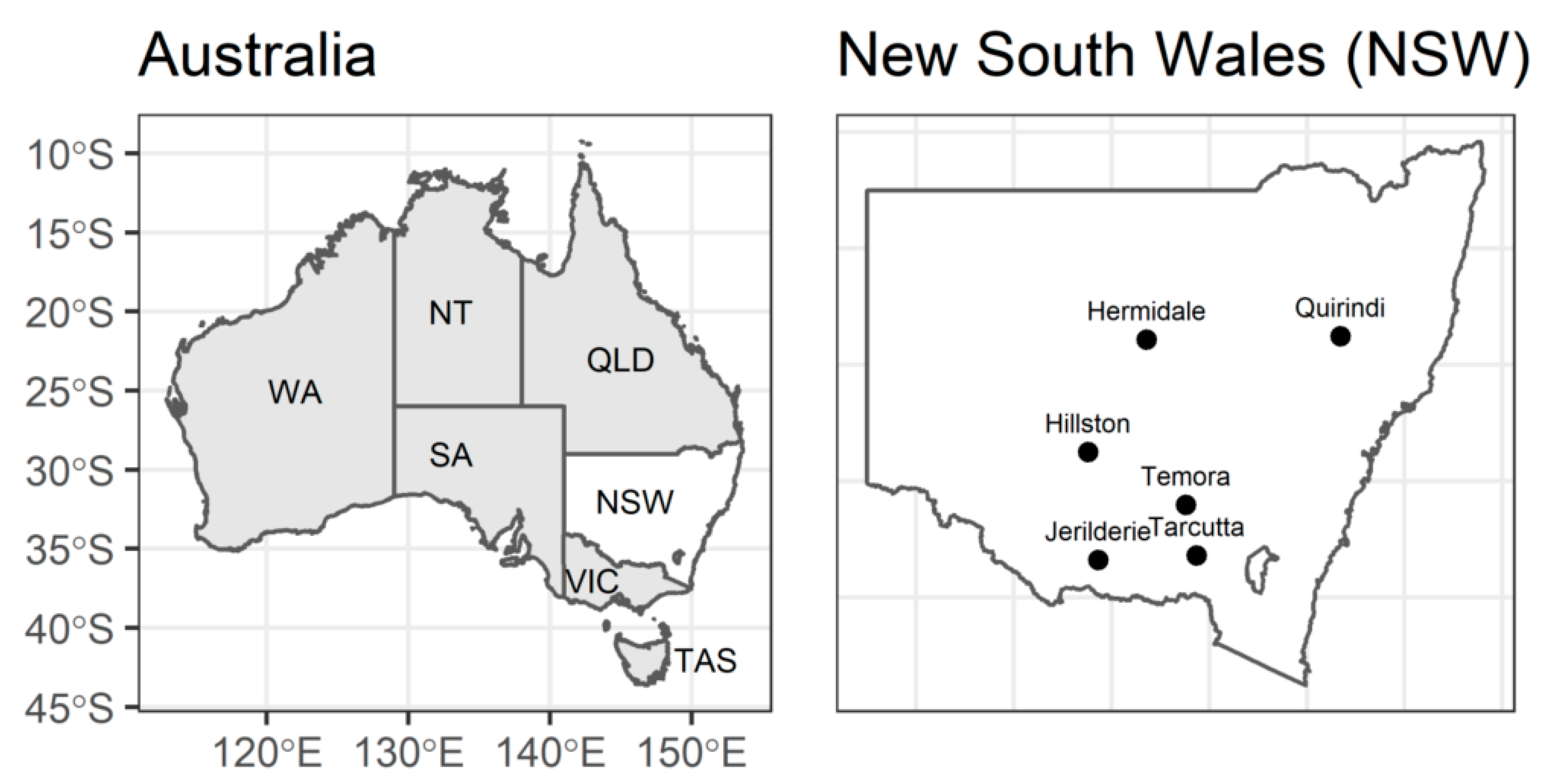
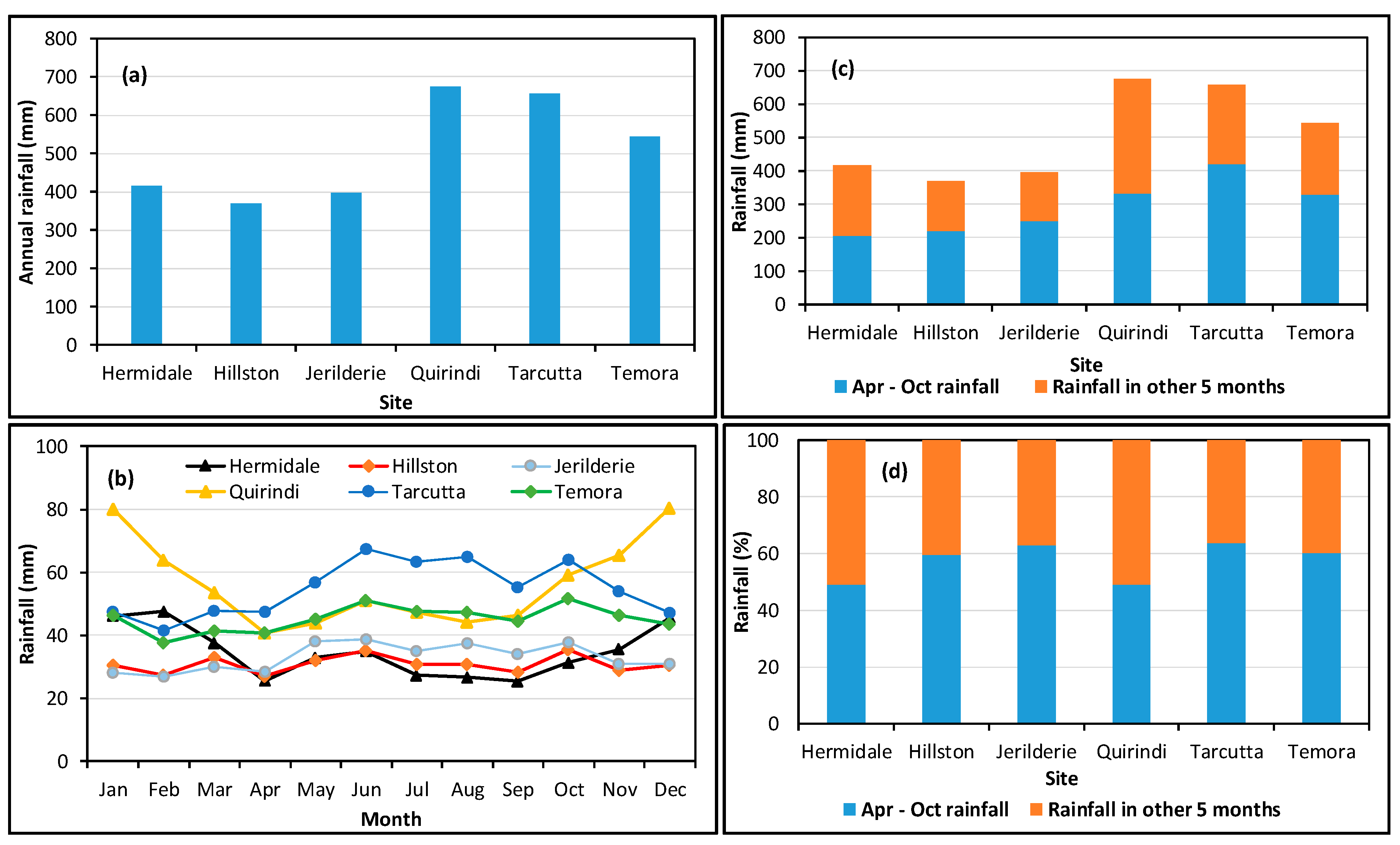
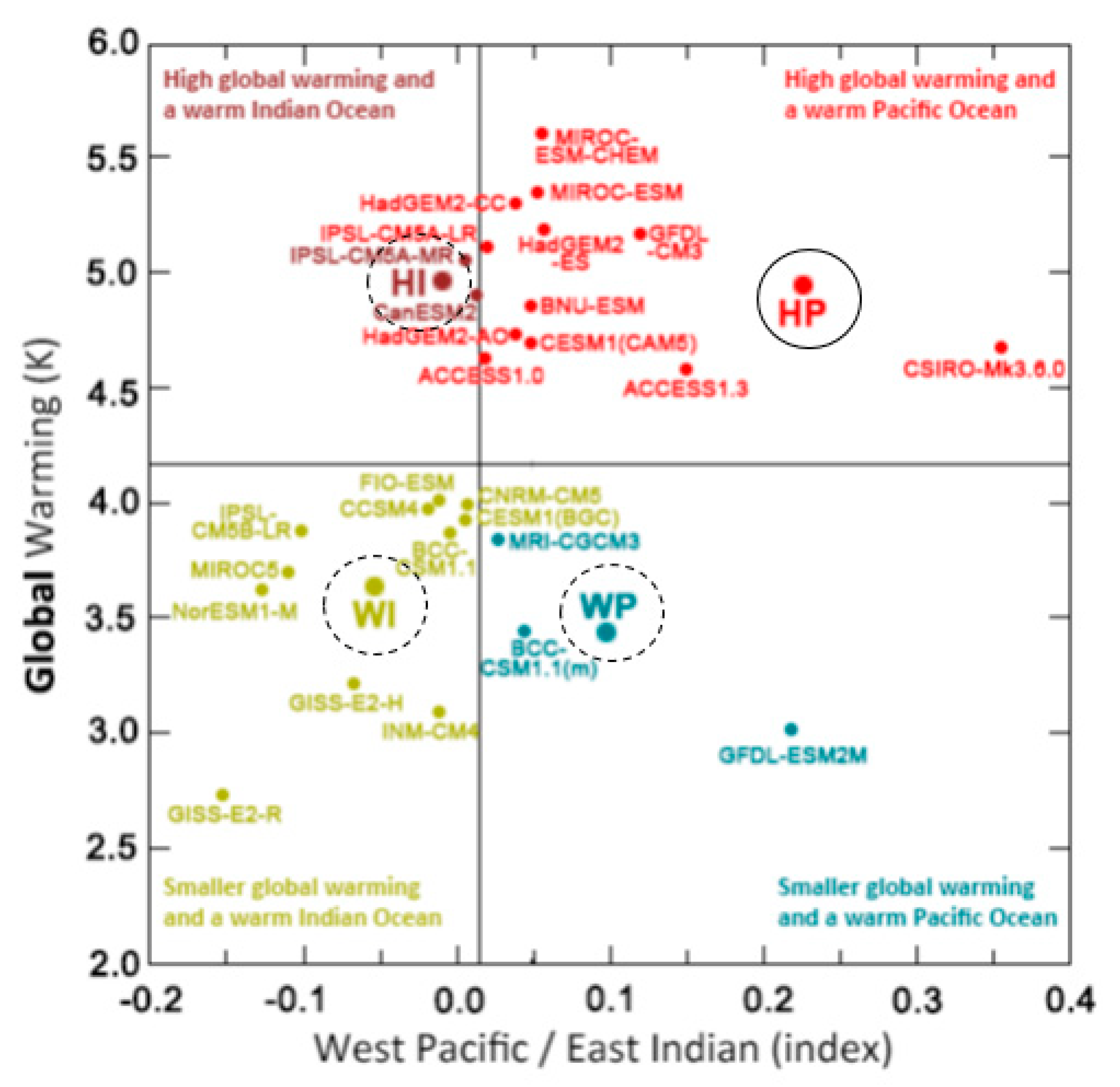
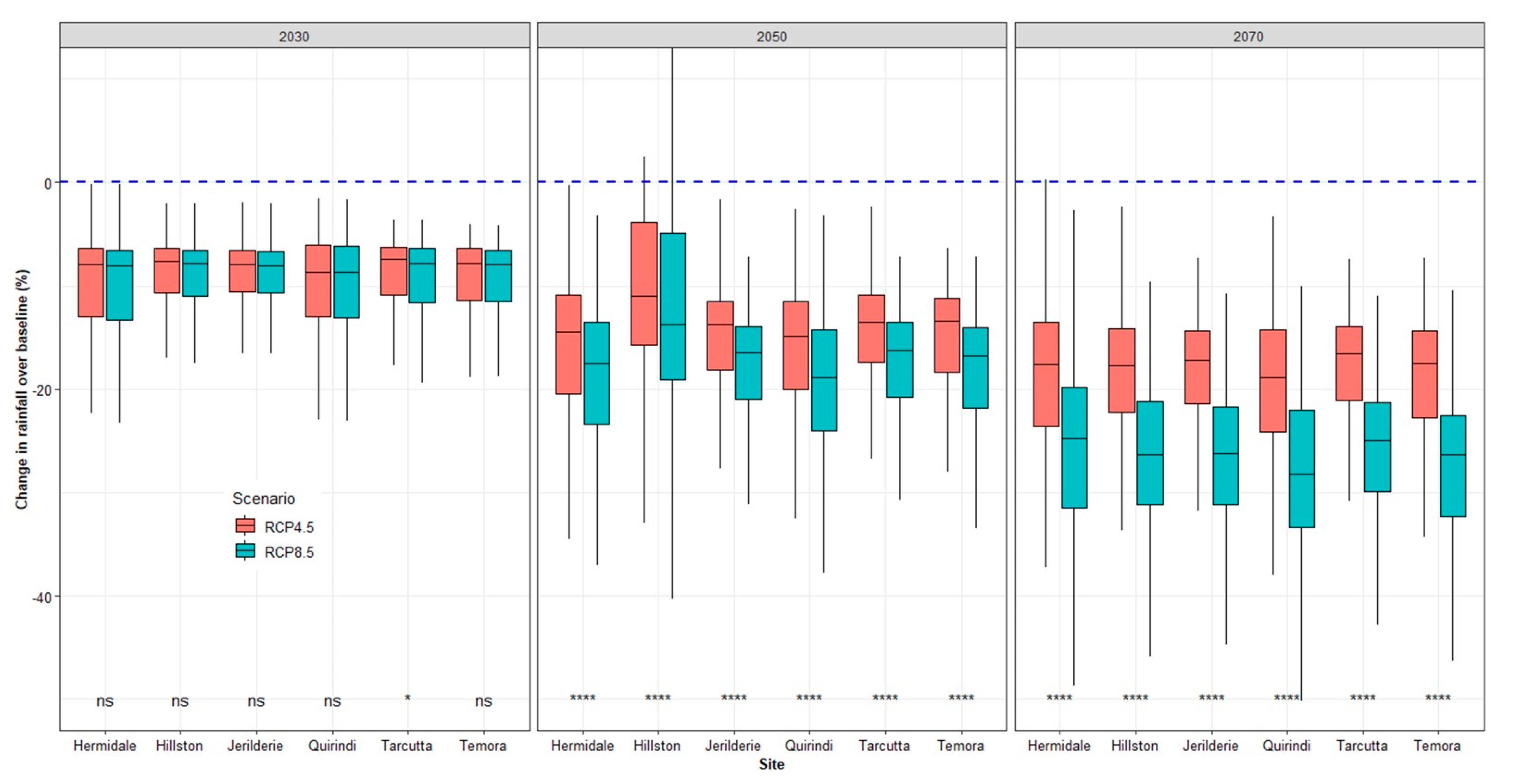

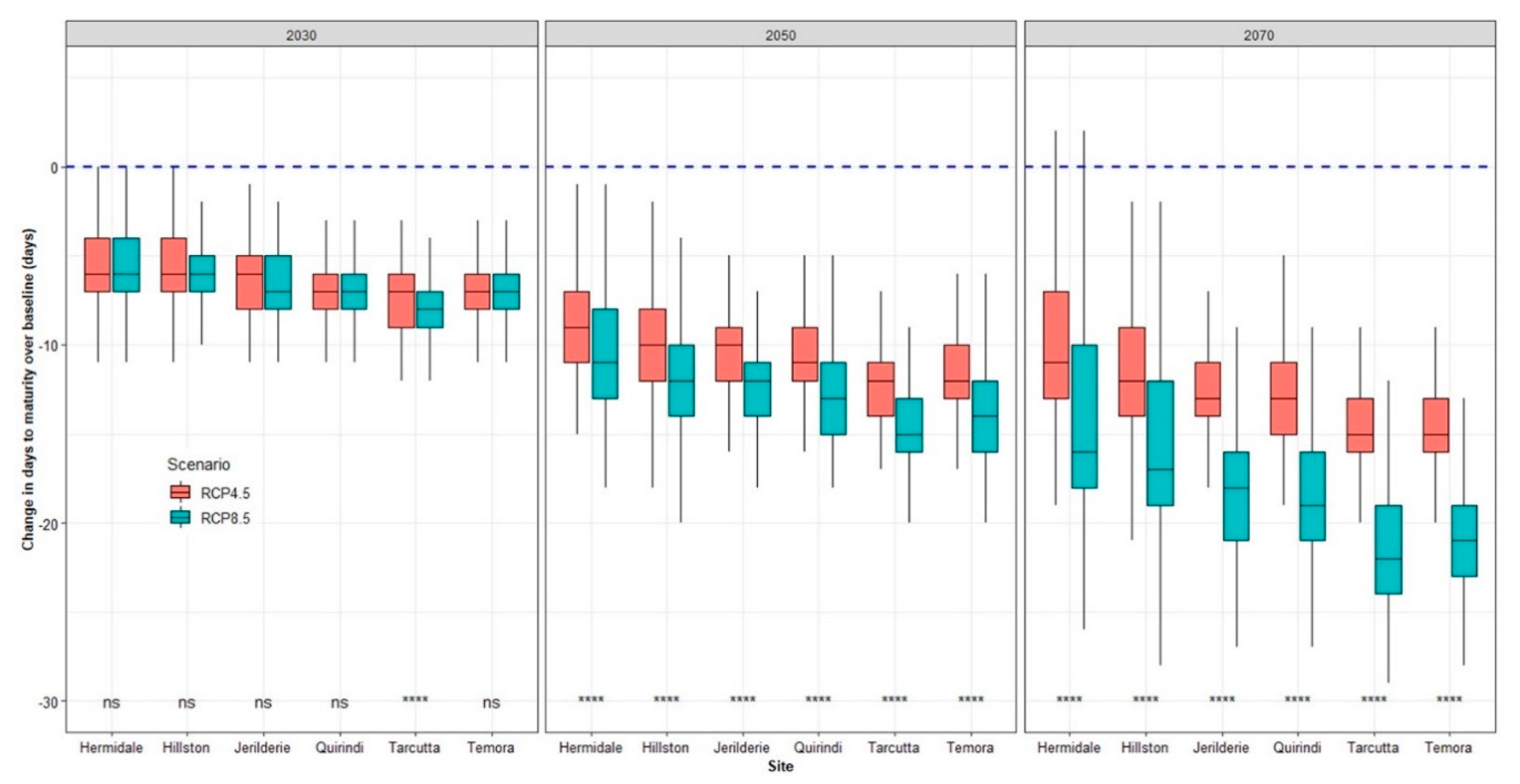
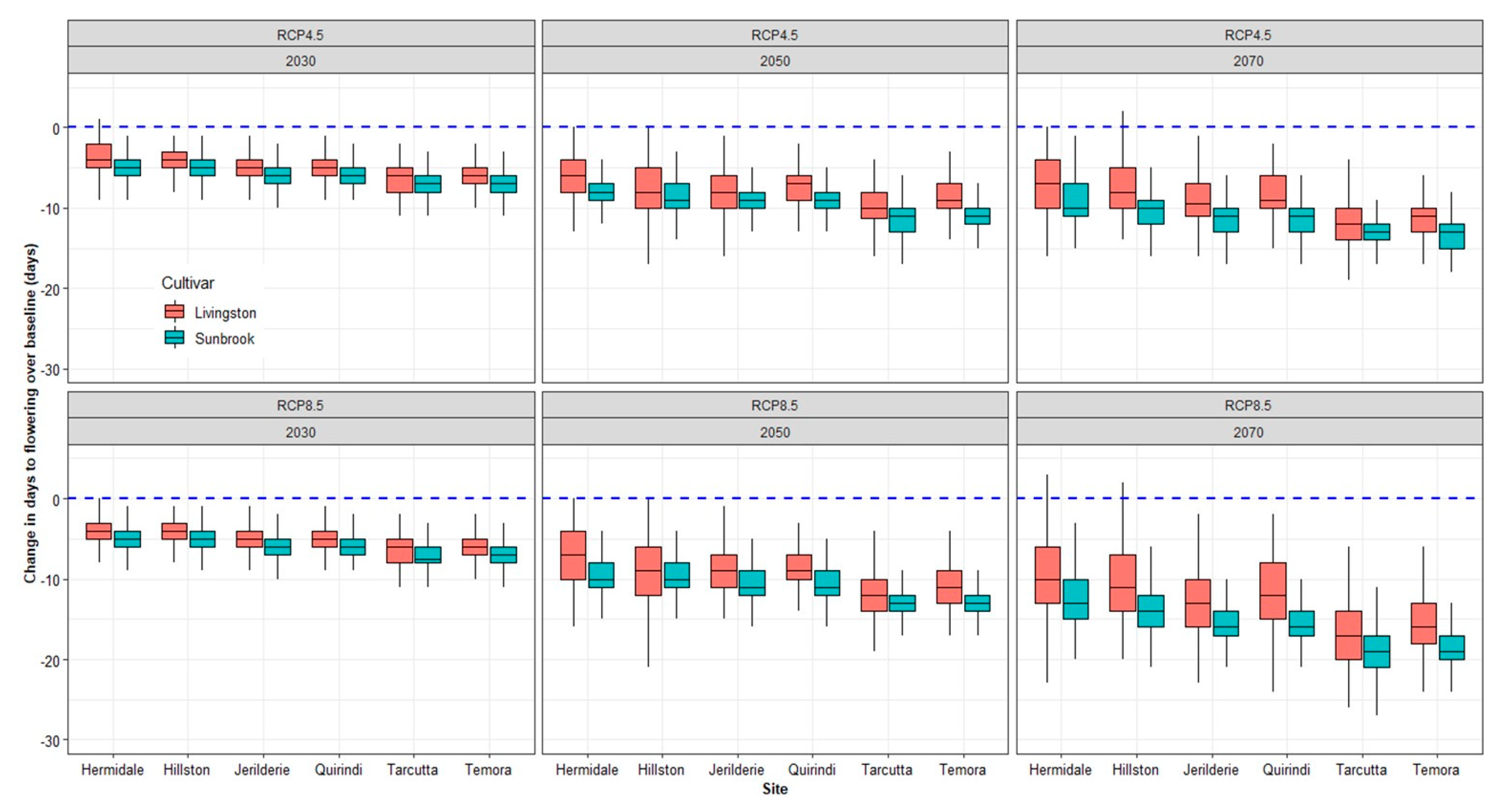
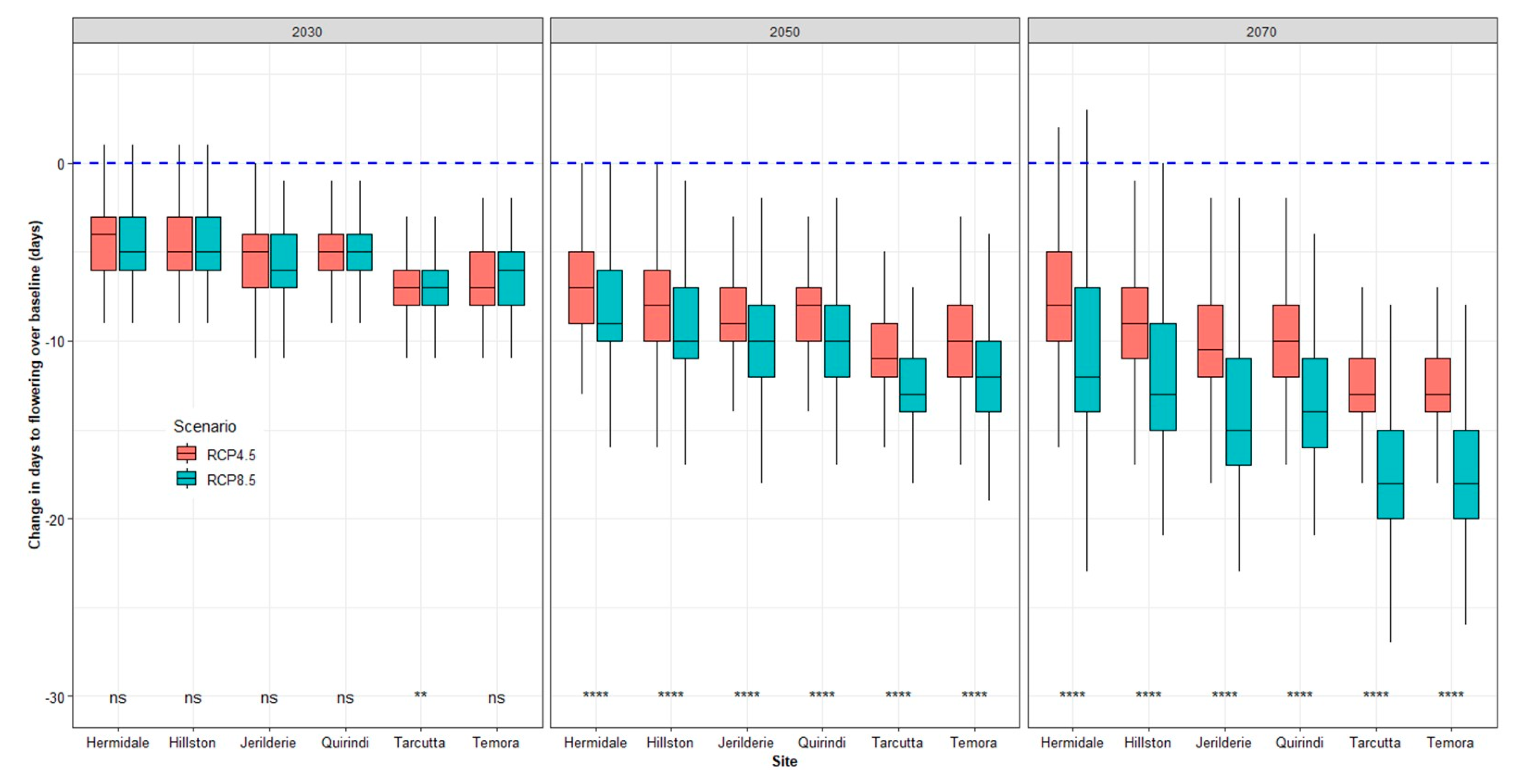
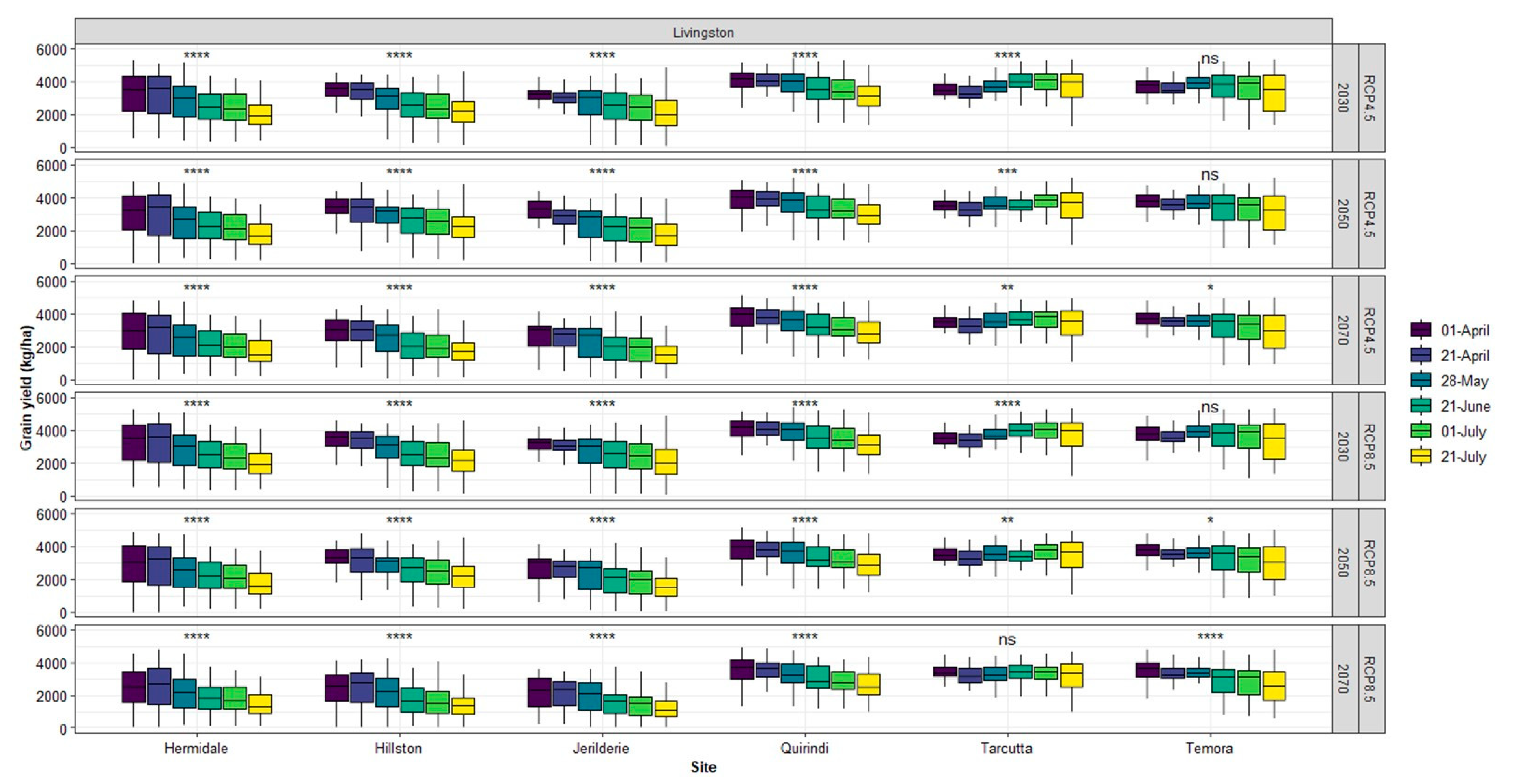

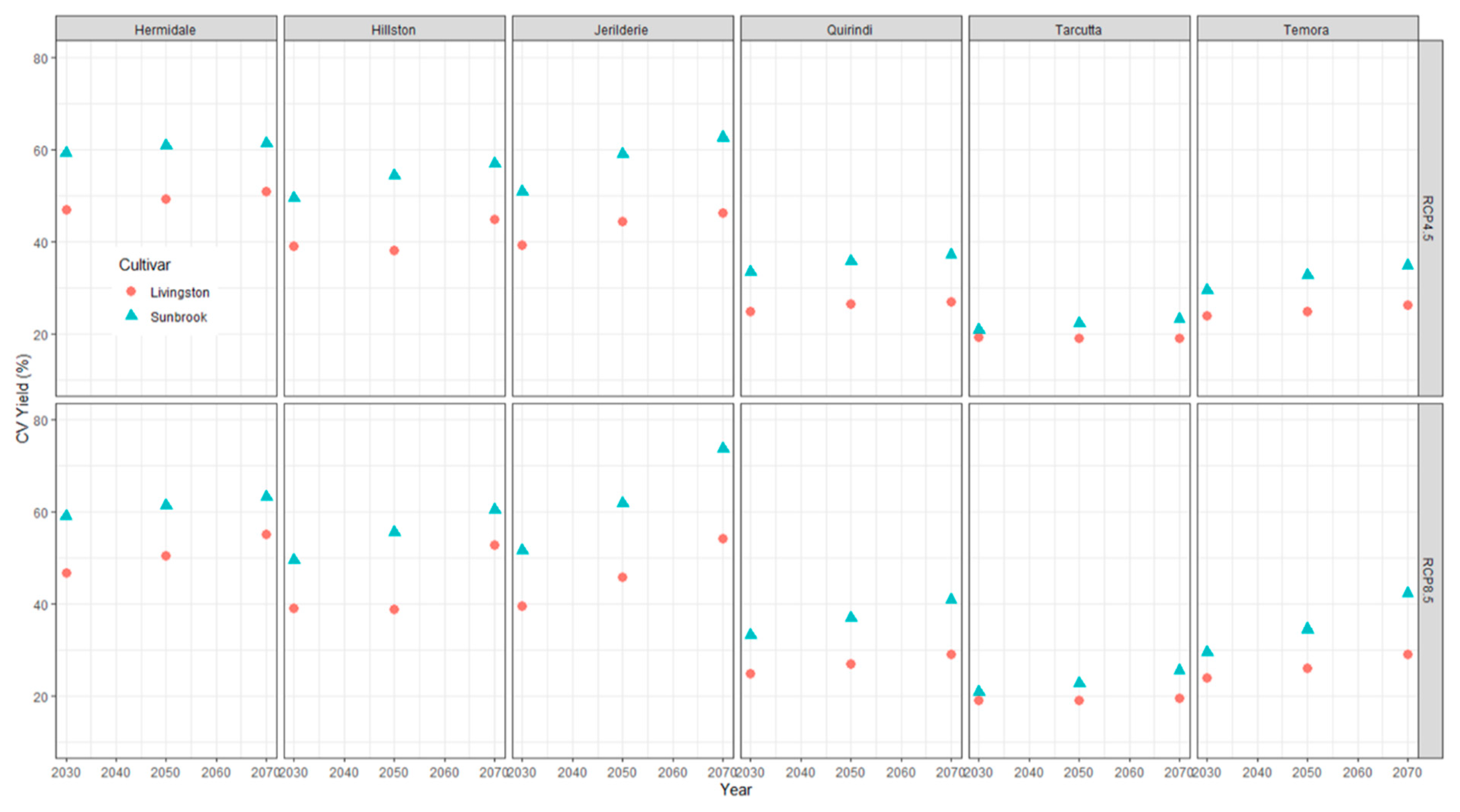
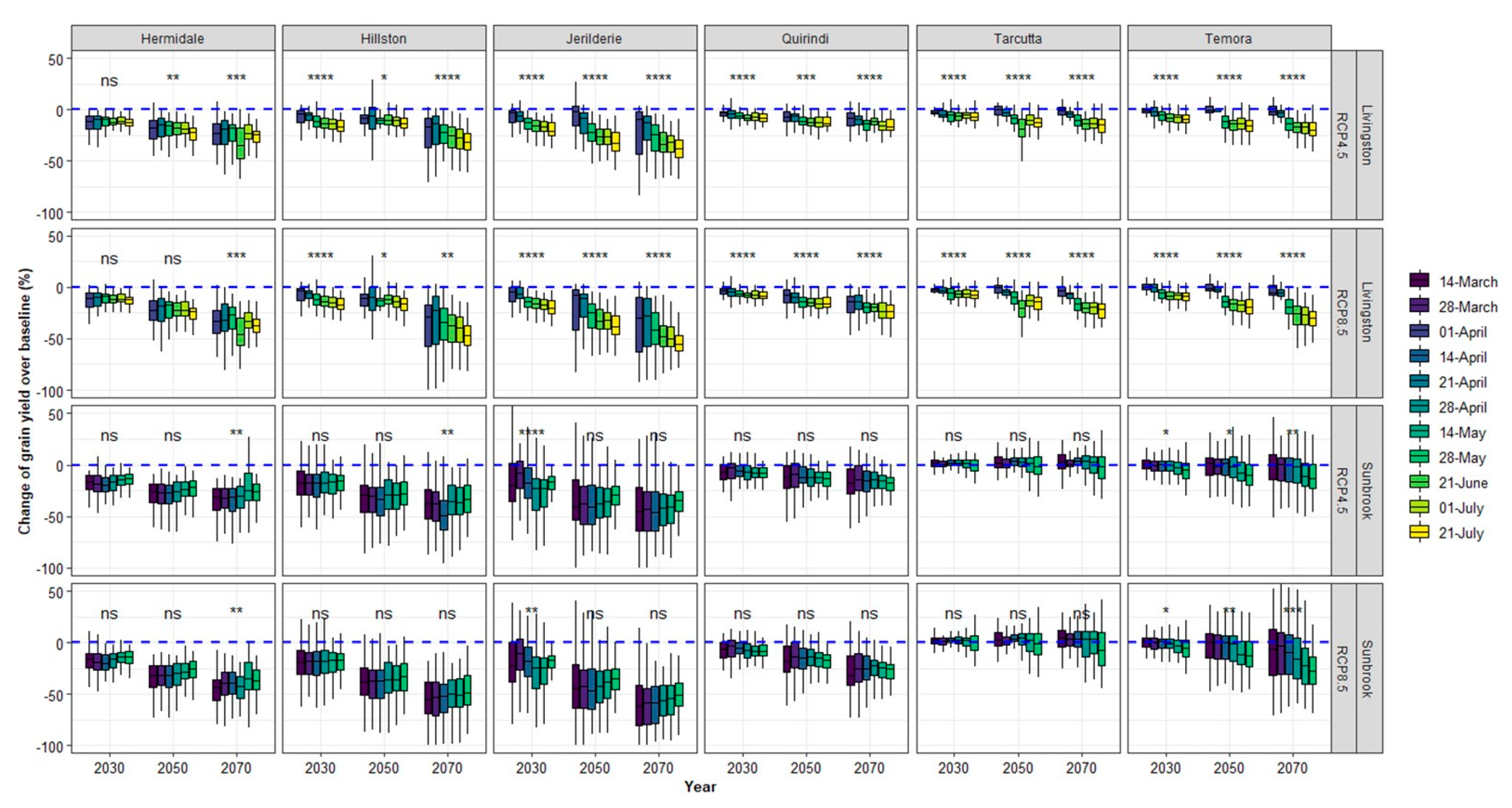
| Sites | Climate Projects | Emission Scenarios | Wheat Cultivars | Sowing Dates | |
|---|---|---|---|---|---|
| Livingston | Sunbrook | ||||
| Hermidale | 2030 | RCP4.5 | Livingston | April Week 1 | March Week 2 |
| Hillston | 2050 | RCP8.5 | Sunbrook | April Week 4 | March Week 4 |
| Jerilderie | 2070 | May Week 3 | April Week 2 | ||
| Quirindi | June Week 3 | April Week 4 | |||
| Tarcutta | July Week 1 | May Week 2 | |||
| Temora | July Week 3 | May Week 4 | |||
Publisher’s Note: MDPI stays neutral with regard to jurisdictional claims in published maps and institutional affiliations. |
© 2021 by the author. Licensee MDPI, Basel, Switzerland. This article is an open access article distributed under the terms and conditions of the Creative Commons Attribution (CC BY) license (http://creativecommons.org/licenses/by/4.0/).
Share and Cite
Zeleke, K. Simulating Agronomic Adaptation Strategies to Mitigate the Impacts of Climate Change on Wheat Yield in South-Eastern Australia. Agronomy 2021, 11, 337. https://doi.org/10.3390/agronomy11020337
Zeleke K. Simulating Agronomic Adaptation Strategies to Mitigate the Impacts of Climate Change on Wheat Yield in South-Eastern Australia. Agronomy. 2021; 11(2):337. https://doi.org/10.3390/agronomy11020337
Chicago/Turabian StyleZeleke, Ketema. 2021. "Simulating Agronomic Adaptation Strategies to Mitigate the Impacts of Climate Change on Wheat Yield in South-Eastern Australia" Agronomy 11, no. 2: 337. https://doi.org/10.3390/agronomy11020337
APA StyleZeleke, K. (2021). Simulating Agronomic Adaptation Strategies to Mitigate the Impacts of Climate Change on Wheat Yield in South-Eastern Australia. Agronomy, 11(2), 337. https://doi.org/10.3390/agronomy11020337





